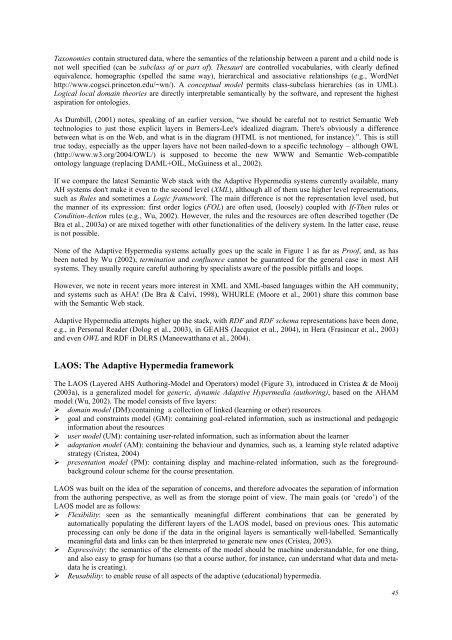Ontologies and the Semantic Web for E-learning - Educational ...
Ontologies and the Semantic Web for E-learning - Educational ...
Ontologies and the Semantic Web for E-learning - Educational ...
Create successful ePaper yourself
Turn your PDF publications into a flip-book with our unique Google optimized e-Paper software.
Taxonomies contain structured data, where <strong>the</strong> semantics of <strong>the</strong> relationship between a parent <strong>and</strong> a child node is<br />
not well specified (can be subclass of or part of). Thesauri are controlled vocabularies, with clearly defined<br />
equivalence, homographic (spelled <strong>the</strong> same way), hierarchical <strong>and</strong> associative relationships (e.g., WordNet<br />
http://www.cogsci.princeton.edu/~wn/). A conceptual model permits class-subclass hierarchies (as in UML).<br />
Logical local domain <strong>the</strong>ories are directly interpretable semantically by <strong>the</strong> software, <strong>and</strong> represent <strong>the</strong> highest<br />
aspiration <strong>for</strong> ontologies.<br />
As Dumbill, (2001) notes, speaking of an earlier version, “we should be careful not to restrict <strong>Semantic</strong> <strong>Web</strong><br />
technologies to just those explicit layers in Berners-Lee's idealized diagram. There's obviously a difference<br />
between what is on <strong>the</strong> <strong>Web</strong>, <strong>and</strong> what is in <strong>the</strong> diagram (HTML is not mentioned, <strong>for</strong> instance).”. This is still<br />
true today, especially as <strong>the</strong> upper layers have not been nailed-down to a specific technology – although OWL<br />
(http://www.w3.org/2004/OWL/) is supposed to become <strong>the</strong> new WWW <strong>and</strong> <strong>Semantic</strong> <strong>Web</strong>-compatible<br />
ontology language (replacing DAML+OIL, McGuiness et al., 2002).<br />
If we compare <strong>the</strong> latest <strong>Semantic</strong> <strong>Web</strong> stack with <strong>the</strong> Adaptive Hypermedia systems currently available, many<br />
AH systems don't make it even to <strong>the</strong> second level (XML), although all of <strong>the</strong>m use higher level representations,<br />
such as Rules <strong>and</strong> sometimes a Logic framework. The main difference is not <strong>the</strong> representation level used, but<br />
<strong>the</strong> manner of its expression: first order logics (FOL) are often used, (loosely) coupled with If-Then rules or<br />
Condition-Action rules (e.g., Wu, 2002). However, <strong>the</strong> rules <strong>and</strong> <strong>the</strong> resources are often described toge<strong>the</strong>r (De<br />
Bra et al., 2003a) or are mixed toge<strong>the</strong>r with o<strong>the</strong>r functionalities of <strong>the</strong> delivery system. In <strong>the</strong> latter case, reuse<br />
is not possible.<br />
None of <strong>the</strong> Adaptive Hypermedia systems actually goes up <strong>the</strong> scale in Figure 1 as far as Proof, <strong>and</strong>, as has<br />
been noted by Wu (2002), termination <strong>and</strong> confluence cannot be guaranteed <strong>for</strong> <strong>the</strong> general case in most AH<br />
systems. They usually require careful authoring by specialists aware of <strong>the</strong> possible pitfalls <strong>and</strong> loops.<br />
However, we note in recent years more interest in XML <strong>and</strong> XML-based languages within <strong>the</strong> AH community,<br />
<strong>and</strong> systems such as AHA! (De Bra & Calvi, 1998), WHURLE (Moore et al., 2001) share this common base<br />
with <strong>the</strong> <strong>Semantic</strong> <strong>Web</strong> stack.<br />
Adaptive Hypermedia attempts higher up <strong>the</strong> stack, with RDF <strong>and</strong> RDF schema representations have been done,<br />
e.g., in Personal Reader (Dolog et al., 2003), in GEAHS (Jacquiot et al., 2004), in Hera (Frasincar et al., 2003)<br />
<strong>and</strong> even OWL <strong>and</strong> RDF in DLRS (Maneewatthana et al., 2004).<br />
LAOS: The Adaptive Hypermedia framework<br />
The LAOS (Layered AHS Authoring-Model <strong>and</strong> Operators) model (Figure 3), introduced in Cristea & de Mooij<br />
(2003a), is a generalized model <strong>for</strong> generic, dynamic Adaptive Hypermedia (authoring), based on <strong>the</strong> AHAM<br />
model (Wu, 2002). The model consists of five layers:<br />
domain model (DM):containing a collection of linked (<strong>learning</strong> or o<strong>the</strong>r) resources<br />
goal <strong>and</strong> constraints model (GM): containing goal-related in<strong>for</strong>mation, such as instructional <strong>and</strong> pedagogic<br />
in<strong>for</strong>mation about <strong>the</strong> resources<br />
user model (UM): containing user-related in<strong>for</strong>mation, such as in<strong>for</strong>mation about <strong>the</strong> learner<br />
adaptation model (AM): containing <strong>the</strong> behaviour <strong>and</strong> dynamics, such as, a <strong>learning</strong> style related adaptive<br />
strategy (Cristea, 2004)<br />
presentation model (PM): containing display <strong>and</strong> machine-related in<strong>for</strong>mation, such as <strong>the</strong> <strong>for</strong>egroundbackground<br />
colour scheme <strong>for</strong> <strong>the</strong> course presentation.<br />
LAOS was built on <strong>the</strong> idea of <strong>the</strong> separation of concerns, <strong>and</strong> <strong>the</strong>re<strong>for</strong>e advocates <strong>the</strong> separation of in<strong>for</strong>mation<br />
from <strong>the</strong> authoring perspective, as well as from <strong>the</strong> storage point of view. The main goals (or ‘credo’) of <strong>the</strong><br />
LAOS model are as follows:<br />
Flexibility: seen as <strong>the</strong> semantically meaningful different combinations that can be generated by<br />
automatically populating <strong>the</strong> different layers of <strong>the</strong> LAOS model, based on previous ones. This automatic<br />
processing can only be done if <strong>the</strong> data in <strong>the</strong> original layers is semantically well-labelled. <strong>Semantic</strong>ally<br />
meaningful data <strong>and</strong> links can be <strong>the</strong>n interpreted to generate new ones (Cristea, 2003).<br />
Expressivity: <strong>the</strong> semantics of <strong>the</strong> elements of <strong>the</strong> model should be machine underst<strong>and</strong>able, <strong>for</strong> one thing,<br />
<strong>and</strong> also easy to grasp <strong>for</strong> humans (so that a course author, <strong>for</strong> instance, can underst<strong>and</strong> what data <strong>and</strong> metadata<br />
he is creating).<br />
Reusability: to enable reuse of all aspects of <strong>the</strong> adaptive (educational) hypermedia.<br />
45
















